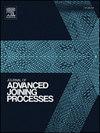Microstructural and defect characterization in single beads of the CrMnFeCoNi high-entropy alloy processed by the multi-beam laser directed energy deposition
IF 3.8
Q2 MATERIALS SCIENCE, MULTIDISCIPLINARY
引用次数: 0
Abstract
This study investigates the microstructural characteristics and defect formation in single beads of the CrMnFeCoNi high-entropy alloy (HEA) processed by the multi-beam laser directed energy deposition (MBL-DED). The research aims to understand how the MBL-DED process can effectively control the bead formation with meltpool or without meltpool by leveraging the multi-beam laser focusing position in the MBL-DED system, and maintain the equiatomic balance of the HEA deposited on substrate surfaces by controlling the bead formation without meltpool and addressing potential defects. The formation of meltpool typically leads to mixing between the base material and the deposited HEA bead, altering the equiatomic balance and reducing the alloy's ability to stabilize the solid-solution phase. The multi-beam laser focusing position of the six laser beams of the MBL-DED system was adjusted to 0.5 mm above the substrate surface, with varying laser powers (80–160 W) and scanning speeds (10–40 mm/s). Hereafter, this laser geometry is called as overfocusing position, ∆f, of 0.5 mm. This method shifted the process dynamics from a conventional meltpool formation to a thin reaction layer formation (no-meltpool formation). At a laser power of 140 W and a scanning speed of 30 mm/s, the absence of meltpool was observed. However, at 120 W, bead discontinuity increased with higher scanning speeds. Additionally, higher speeds and lower powers resulted in increased porosity, supported by partially melted and unmelted powder. Microstructural analysis revealed that increasing scanning speeds reduced grain size, transitioning from larger and uniform grains to finer and irregular grains. This research demonstrates the potential of the MBL-DED system in optimizing the HEA powder processing by controlling meltpool formation and mitigating defects, and in contributing to open up a new joining processing technology with less reaction layer through additive manufacturing.
多束激光定向能沉积法制备CrMnFeCoNi高熵合金单微珠的显微组织和缺陷表征
研究了多束激光定向能沉积(MBL-DED)法制备的CrMnFeCoNi高熵合金(HEA)的微观组织特征和缺陷形成过程。本研究旨在了解MBL-DED工艺如何利用MBL-DED系统中的多束激光聚焦位置,有效控制有熔池或无熔池的熔头形成,并通过控制无熔池的熔头形成和解决潜在缺陷来维持沉积在衬底表面的HEA的等原子平衡。熔池的形成通常会导致基材和沉积的HEA珠之间的混合,改变等原子平衡,降低合金稳定固溶相的能力。在不同的激光功率(80 ~ 160 W)和扫描速度(10 ~ 40 mm/s)下,将MBL-DED系统的6束多束激光聚焦位置调整到距衬底表面0.5 mm。此后,这种激光几何形状被称为0.5 mm的过聚焦位置∆f。该方法将过程动力学从传统的熔池形成转变为薄反应层形成(无熔池形成)。在激光功率为140 W,扫描速度为30 mm/s时,观察到无熔池。然而,在120w时,随着扫描速度的增加,磁珠的不连续度增加。此外,更高的速度和更低的功率导致孔隙度增加,由部分熔化和未熔化的粉末支撑。显微组织分析表明,随着扫描速度的增加,晶粒尺寸减小,晶粒由较大的均匀晶粒转变为细小的不规则晶粒。本研究证明了MBL-DED系统在通过控制熔池形成和减少缺陷来优化HEA粉末加工方面的潜力,并有助于通过增材制造开辟一种较少反应层的连接加工新技术。
本文章由计算机程序翻译,如有差异,请以英文原文为准。
求助全文
约1分钟内获得全文
求助全文

 求助内容:
求助内容: 应助结果提醒方式:
应助结果提醒方式:


